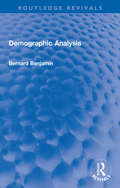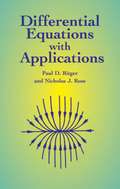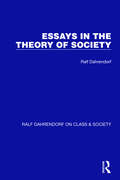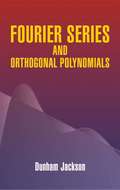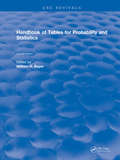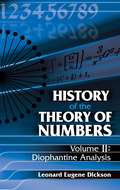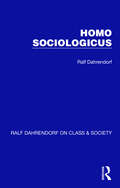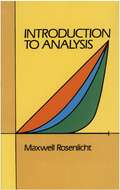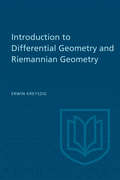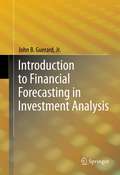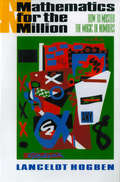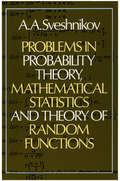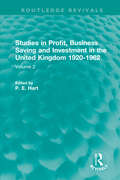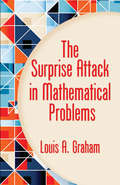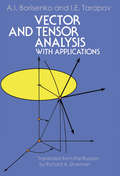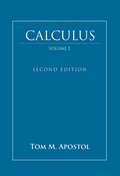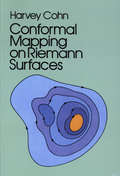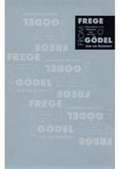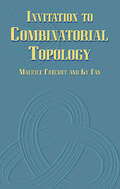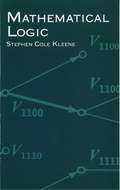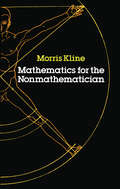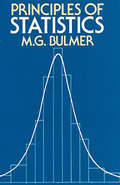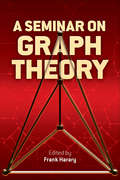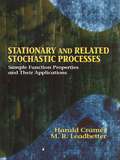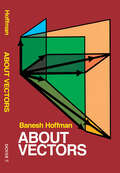- Table View
- List View
Demographic Analysis (Routledge Revivals)
by Bernard BenjaminFirst published in 1968, Demographic Analysis was written to provide a comprehensive account of demographic methods for those with a need to understand population movements. The book provides an introduction to some of the key tools used by demographers and the principal sources of population data. Beginning with an overview of the scope, content and use of the population census, it then examines methods for measuring births, deaths, and migration before setting out the methodology for determining the contributions of these elements to population change and estimating past or future changes. The book also explores sickness as a population characteristic and a way of better understanding mortality variations.
Differential Equations With Applications
by Paul D. Ritger Nicholas J. RoseCoherent introductory text focuses on initial- and boundary-value problems, general properties of linear equations, and differences between linear and nonlinear systems. Answers to most problems.
Essays in the Theory of Society (Ralf Dahrendorf on Class & Society #2)
by Ralf DahrendorfOriginally published in 1968, these ten essays by one of Europe’s leading sociological theorists deal with important issues on the borderline between sociology and social philosophy and demonstrate the author’s deep insight into history and political analysis. The author maintains that the structures of power in which the political process takes place not only originate change and give it direction, but also produce the fertile conflicts that give expression to the fundamental uncertainty of human existence. Through an examination of various concepts inherent in this dynamic process – power, resistance, conflict, change, freedom, uncertainty – a coherent theory of society emerges.
Fourier Series and Orthogonal Polynomials: The Carus Mathematical Monographs, No. 6
by Dunham JacksonThis text for undergraduate and graduate students illustrates the fundamental simplicity of the properties of orthogonal functions and their developments in related series. Starting with a definition and explanation of the elements of Fourier series, the text follows with examinations of Legendre polynomials and Bessel functions. Boundary value problems consider Fourier series in conjunction with Laplace's equation in an infinite strip and in a rectangle, with a vibrating string, in three dimensions, in a sphere, and in other circumstances. An overview of Pearson frequency functions is followed by chapters on orthogonal, Jacobi, Hermite, and Laguerre polynomials, and the text concludes with a chapter on convergence. 1941 edition.
Handbook of Tables for Probability and Statistics
by William H. BeyerPracticing statisticians and scientists working in diverse fields need an authoritative reference handbook of statistical tables developed to "aid" in the investigation and solution of many of today's challenging problems. This book has been compiled and arranged to meet the needs of these users of statistics.
History of the Theory of Numbers, Volume II: Diophantine Analysis
by Leonard Eugene DicksonThe three-volume series History of the Theory of Numbers is the work of the distinguished mathematician Leonard Eugene Dickson, who taught at the University of Chicago for four decades and is celebrated for his many contributions to number theory and group theory. This second volume in the series, which is suitable for upper-level undergraduates and graduate students, is devoted to the subject of diophantine analysis. It can be read independently of the preceding volume, which explores divisibility and primality, and volume III, which examines quadratic and higher forms.Featured topics include polygonal, pyramidal, and figurate numbers; linear diophantine equations and congruences; partitions; rational right triangles; triangles, quadrilaterals, and tetrahedra; the sums of two, three, four, and n squares; the number of solutions of quadratic congruences in n unknowns; Liouville's series of eighteen articles; the Pell equation; squares in arithmetical or geometrical progression; equations of degrees three, four, and n; sets of integers with equal sums of like powers; Waring's problem and related results; Fermat's last theorem; and many other related subjects. Indexes of authors cited and subjects appear at the end of the book.
Homo Sociologicus (Ralf Dahrendorf on Class & Society #3)
by Ralf DahrendorfFirst published in English as part of the Essays in the Theory of Society, this volume reissues the stand-alone Homo Sociologicus for which the author wrote a new introduction when it was originally published in 1973. The controversial book deals with the history, significance and limits of the category of social role and discusses the dilemma posed by homo sociologicus. The author shows that for society and sociology, socialization invariably means depersonalization, the yielding up of man’s absolute individuality and liberty to the constraint and generality of social roles. This volume includes the essay, Sociology and Human Nature, written as a postscript to Homo Sociologicus.
Introduction to Analysis
by Maxwell RosenlichtWritten for junior and senior undergraduates, this remarkably clear and accessible treatment covers set theory, the real number system, metric spaces, continuous functions, Riemann integration, multiple integrals, and more. Rigorous and carefully presented, the text assumes a year of calculus and features problems at the end of each chapter. 1968 edition.
Introduction to Differential Geometry and Riemannian Geometry (Mathematical Expositions #16)
by Erwin KreyszigThis book provides an introduction to the differential geometry of curves and surfaces in three-dimensional Euclidean space and to n-dimensional Riemannian geometry. Based on Kreyszig's earlier book Differential Geometry, it is presented in a simple and understandable manner with many examples illustrating the ideas, methods, and results.<P><P> Among the topics covered are vector and tensor algebra, the theory of surfaces, the formulae of Weingarten and Gauss, geodesics, mappings of surfaces and their applications, and global problems. A thorough investigation of Reimannian manifolds is made, including the theory of hypersurfaces. <P> Interesting problems are provided and complete solutions are given at the end of the book together with a list of the more important formulae. Elementary calculus is the sole prerequisite for the understanding of this detailed and complete study in mathematics.
Introduction to Financial Forecasting in Investment Analysis
by John B. Guerard Jr.Forecasting--the art and science of predicting future outcomes--has become a crucial skill in business and economic analysis. This volume introduces the reader to the tools, methods, and techniques of forecasting, specifically as they apply to financial and investing decisions. With an emphasis on "earnings per share" (eps), the author presents a data-oriented text on financial forecasting, understanding financial data, assessing firm financial strategies (such as share buybacks and R&D spending), creating efficient portfolios, and hedging stock portfolios with financial futures. The opening chapters explain how to understand economic fluctuations and how the stock market leads the general economic trend; introduce the concept of portfolio construction and how movements in the economy influence stock price movements; and introduce the reader to the forecasting process, including exponential smoothing and time series model estimations. Subsequent chapters examine the composite index of leading economic indicators (LEI); review financial statement analysis and mean-variance efficient portfolios; and assess the effectiveness of analysts' earnings forecasts. Using data from such firms as Intel, General Electric, and Hitachi, Guerard demonstrates how forecasting tools can be applied to understand the business cycle, evaluate market risk, and demonstrate the impact of global stock selection modeling and portfolio construction.
Mathematics for the Million: How to Master the Magic of Numbers
by Lancelot Hogben"It makes alive the contents of the elements of mathematics."--Albert Einstein Taking only the most elementary knowledge for granted, Lancelot Hogben leads readers of this famous book through the whole course from simple arithmetic to calculus. His illuminating explanation is addressed to the person who wants to understand the place of mathematics in modern civilization but who has been intimidated by its supposed difficulty. Mathematics is the language of size, shape, and order--a language Hogben shows one can both master and enjoy.
Problems in Probability Theory, Mathematical Statistics and Theory of Random Functions
by A. A. SveshnikovProblem solving is the main thrust of this excellent, well-organized workbook. Suitable for students at all levels in probability theory and statistics, the book presents over 1,000 problems and their solutions, illustrating fundamental theory and representative applications in the following fields: Random Events; Distribution Laws; Correlation Theory; Random Variables; Entropy & Information; Markov Processes; Systems of Random Variables; Limit Theorems; Data Processing; and more.The coverage of topics is both broad and deep, ranging from the most elementary combinatorial problems through limit theorems and information theory. Each chapter introduction sets forth the basic formulas and a general outline of the theory necessary for the problems that follow. Next comes a group of sample problems and their solutions, worked out in detail, which serve as effective orientation for the exercises to come.The emphasis on problem solving and the multitude of problems presented make this book, translated from the Russian, a valuable reference manual for scientists, engineers, and computer specialists, as well as a comprehensive workbook for undergraduates in these fields.
Studies in Profit, Business Saving and Investment in the United Kingdom 1920-1962: Volume 2 (Routledge Revivals)
by P. E. HartOriginally published in 1968, this second volume of the Glasgow Studies in Profit, Business Saving and Investment uses the financial data assembled in Volume 1 to test economic theories of the factor distribution income, of the appropriation of profit, of the determinants of investment, and of the return on capital. The tests enabled the measurement of long-run and short-run variation of the ratio of profit to employee compensation in the United Kingdom at the level of individual industries and the whole industrial sector. As well as measuring the relationship between a company’s sales or profits and its expenditure on fixed assets, the book describes the long-term decline in the rate of return on capital in the UK and measures the effect of the intensity of competition on this return.
The Surprise Attack in Mathematical Problems
by Louis A. GrahamFor decades, professionals in applied mathematics and mathematical puzzle fans from all over the world supplied provocative problems to the puzzle columns of the Graham Dial. Upon the appearance of an interesting problem, readers wrote in to the Dial suggesting new approaches to the solution, some greatly simplifying the problem and others broadening its scope. This collection presents 52 of the finest problems, all featuring the "surprise attack" and abounding in imaginative and interesting solutions.The problems involve measurement of geometrical spaces, probabilities, distances, number systems other than the decimal, interesting number relations, relative motion, and the discovery of the simplest solution through purely logical means. Solutions involve such techniques as arithmetic, algebra and geometry, number theory, statistics, networks, and inversion. Several approaches to the solution accompany each problem, and even the best of these represent not the ideal solution but only the most satisfying — so far.
Vector and Tensor Analysis with Applications
by Richard A. Silverman A. I. Borisenko I. E. TarapovConcise and readable, this text ranges from definition of vectors and discussion of algebraic operations on vectors to the concept of tensor and algebraic operations on tensors. It also includes a systematic study of the differential and integral calculus of vector and tensor functions of space and time. Worked-out problems and solutions. 1968 edition.
Calculus, Volume 1
by Tom M. ApostolAn introduction to the Calculus, with an excellent balance between theory and technique. Integration is treated before differentiation--this is a departure from most modern texts, but it is historically correct, and it is the best way to establish the true connection between the integral and the derivative. Proofs of all the important theorems are given, generally preceded by geometric or intuitive discussion. This Second Edition introduces the mean-value theorems and their applications earlier in the text, incorporates a treatment of linear algebra, and contains many new and easier exercises. As in the first edition, an interesting historical introduction precedes each important new concept.
Conformal Mapping on Riemann Surfaces (Dover Books on Mathematics)
by Harvey CohnThe subject matter loosely called "Riemann surface theory" has been the starting point for the development of topology, functional analysis, modern algebra, and any one of a dozen recent branches of mathematics; it is one of the most valuable bodies of knowledge within mathematics for a student to learn.Professor Cohn's lucid and insightful book presents an ideal coverage of the subject in five parts. Part I is a review of complex analysis analytic behavior, the Riemann sphere, geometric constructions, and presents (as a review) a microcosm of the course. The Riemann manifold is introduced in Part II and is examined in terms of intuitive physical and topological technique in Part III. In Part IV the author shows how to define real functions on manifolds analogously with the algebraic and analytic points of view outlined here. The exposition returns in Part V to the use of a single complex variable z. As the text is richly endowed with problem material -- 344 exercises -- the book is perfect for self-study as well as classroom use.Harvey Cohn is well-known in the mathematics profession for his pedagogically superior texts, and the present book will be of great interest not only to pure and applied mathematicians, but also engineers and physicists. Dr. Cohn is currently Distinguished Professor of Mathematics at the City University of New York Graduate Center.
From Frege to Godel: A Source Book in Mathematical Logic, 1879-1931
by Jean Van HeijenoortThe fundamental texts of the great classical period in modern logic, some of them never before available in English translation, are here gathered together for the first time. Modern logic, heralded by Leibniz, may be said to have been initiated by Boole, De Morgan, and Jevons, but it was the publication in 1879 of Gottlob Frege’s Begriffsschrift that opened a great epoch in the history of logic by presenting, in full-fledged form, the propositional calculus and quantification theory. <p><p> Frege’s book, translated in its entirety, begins the present volume. The emergence of two new fields, set theory and foundations of mathematics, on the borders of logic, mathematics, and philosophy, is depicted by the texts that follow. Peano and Dedekind illustrate the trend that led to Principia Mathematica. Burali-Forti, Cantor, Russell, Richard, and König mark the appearance of the modern paradoxes. Hilbert, Russell, and Zermelo show various ways of overcoming these paradoxes and initiate, respectively, proof theory, the theory of types, and axiomatic set theory. Skolem generalizes Löwenheim’s theorem, and he and Fraenkel amend Zermelo’s axiomatization of set theory, while von Neumann offers a somewhat different system. The controversy between Hubert and Brouwer during the twenties is presented in papers of theirs and in others by Weyl, Bernays, Ackermann, and Kolmogorov. The volume concludes with papers by Herbrand and by Gödel, including the latter’s famous incompleteness paper. <p> Of the forty-five contributions here collected all but five are presented in extenso. Those not originally written in English have been translated with exemplary care and exactness; the translators are themselves mathematical logicians as well as skilled interpreters of sometimes obscure texts. Each paper is introduced by a note that sets it in perspective, explains its importance, and points out difficulties in interpretation. Editorial comments and footnotes are interpolated where needed, and an extensive bibliography is included.
Invitation to Combinatorial Topology (Dover Books on Mathematics)
by Ky Fan Maurice Fréchet Howard W. EvesAn elementary text that can be understood by anyone with a background in high school geometry, Invitation to Combinatorial Topology offers a stimulating initiation to important topological ideas. This translation from the original French does full justice to the text's coherent presentation as well as to its rich historical content. Subjects include the problems inherent to coloring maps, homeomorphism, applications of Descartes' theorem, and topological polygons. Considerations of the topological classification of closed surfaces cover elementary operations, use of normal forms of polyhedra, reduction to normal form, and application to the geometric theory of functions. 1967 edition. 108 figures. Bibliography. Index.
Mathematical Logic
by Stephen Cole KleeneUndergraduate students with no prior classroom instruction in mathematical logic will benefit from this evenhanded multipart text. It begins with an elementary but thorough overview of mathematical logic of first order. The treatment extends beyond a single method of formulating logic to offer instruction in a variety of techniques: model theory (truth tables), Hilbert-type proof theory, and proof theory handled through derived rules.The second part supplements the previously discussed material and introduces some of the newer ideas and the more profound results of twentieth-century logical research. Subsequent chapters explore the study of formal number theory, with surveys of the famous incompleteness and undecidability results of Godel, Church, Turing, and others. The emphasis in the final chapter reverts to logic, with examinations of Godel's completeness theorem, Gentzen's theorem, Skolem's paradox and nonstandard models of arithmetic, and other theorems. The author, Stephen Cole Kleene, was Cyrus C. MacDuffee Professor of Mathematics at the University of Wisconsin, Madison. Preface. Bibliography. Theorem and Lemma Numbers: Pages. List of Postulates. Symbols and Notations. Index.
Mathematics for the Nonmathematician
by Morris KlinePractical, scientific, philosophical, and artistic problems have caused men to investigate mathematics. But there is one other motive which is as strong as any of these--the search for beauty. Mathematics is an art, and as such affords the pleasures which all the arts afford." In this erudite, entertaining college-level text, Morris Kline, Professor Emeritus of Mathematics at New York University, provides the liberal arts student with a detailed treatment of mathematics in a cultural and historical context. The book can also act as a self-study vehicle for advanced high school students and laymen. Professor Kline begins with an overview, tracing the development of mathematics to the ancient Greeks, and following its evolution through the Middle Ages and the Renaissance to the present day. Subsequent chapters focus on specific subject areas, such as "Logic and Mathematics," "Number: The Fundamental Concept," "Parametric Equations and Curvilinear Motion," "The Differential Calculus," and "The Theory of Probability." Each of these sections offers a step-by-step explanation of concepts and then tests the student's understanding with exercises and problems. At the same time, these concepts are linked to pure and applied science, engineering, philosophy, the social sciences or even the arts.In one section, Professor Kline discusses non-Euclidean geometry, ranking it with evolution as one of the "two concepts which have most profoundly revolutionized our intellectual development since the nineteenth century." His lucid treatment of this difficult subject starts in the 1800s with the pioneering work of Gauss, Lobachevsky, Bolyai and Riemann, and moves forward to the theory of relativity, explaining the mathematical, scientific and philosophical aspects of this pivotal breakthrough. Mathematics for the Nonmathematician exemplifies Morris Kline's rare ability to simplify complex subjects for the nonspecialist.
Principles of Statistics
by M. G. BulmerThere are many textbooks which describe current methods of statistical analysis, while neglecting related theory. There are equally many advanced textbooks which delve into the far reaches of statistical theory, while bypassing practical applications. But between these two approaches is an unfilled gap, in which theory and practice merge at an intermediate level. Professor M. G. Bulmer's Principles of Statistics, originally published in 1965, was created to fill that need. The new, corrected Dover edition of Principles of Statistics makes this invaluable mid-level text available once again for the classroom or for self-study. Principles of Statistics was created primarily for the student of natural sciences, the social scientist, the undergraduate mathematics student, or anyone familiar with the basics of mathematical language. It assumes no previous knowledge of statistics or probability; nor is extensive mathematical knowledge necessary beyond a familiarity with the fundamentals of differential and integral calculus. (The calculus is used primarily for ease of notation; skill in the techniques of integration is not necessary in order to understand the text.)Professor Bulmer devotes the first chapters to a concise, admirably clear description of basic terminology and fundamental statistical theory: abstract concepts of probability and their applications in dice games, Mendelian heredity, etc.; definitions and examples of discrete and continuous random variables; multivariate distributions and the descriptive tools used to delineate them; expected values; etc. The book then moves quickly to more advanced levels, as Professor Bulmer describes important distributions (binomial, Poisson, exponential, normal, etc.), tests of significance, statistical inference, point estimation, regression, and correlation. Dozens of exercises and problems appear at the end of various chapters, with answers provided at the back of the book. Also included are a number of statistical tables and selected references.
A Seminar on Graph Theory (Dover Books on Mathematics)
by Frank HararyPresented in 1962–63 by experts at University College, London, these lectures offer a variety of perspectives on graph theory. Although the opening chapters form a coherent body of graph theoretic concepts, this volume is not a text on the subject but rather an introduction to the extensive literature of graph theory. The seminar's topics are geared toward advanced undergraduate students of mathematics.Lectures by this volume's editor, Frank Harary, include "Some Theorems and Concepts of Graph Theory," "Topological Concepts in Graph Theory," "Graphical Reconstruction," and other introductory talks. A series of invited lectures follows, featuring presentations by other authorities on the faculty of University College as well as visiting scholars. These include "Extremal Problems in Graph Theory" by Paul Erdös, "Complete Bipartite Graphs: Decomposition into Planar Subgraphs," by Lowell W. Beineke, "Graphs and Composite Games," by Cedric A. B. Smith, and several others.
Stationary and Related Stochastic Processes: Sample Function Properties and Their Applications
by M. Ross Leadbetter Harald CramérThis graduate-level text offers a comprehensive account of the general theory of stationary processes, with special emphasis on the properties of sample functions. Assuming a familiarity with the basic features of modern probability theory, the text develops the foundations of the general theory of stochastic processes, examines processes with a continuous-time parameter, and applies the general theory to procedures key to the study of stationary processes. Additional topics include analytic properties of the sample functions and the problem of time distribution of the intersections between a sample function. 1967 edition.
About Vectors (Dover Books on Mathematics)
by Banesh HoffmannFrom his unusual beginning in "Defining a vector" to his final comments on "What then is a vector?" author Banesh Hoffmann has written a book that is provocative and unconventional. In his emphasis on the unresolved issue of defining a vector, Hoffmann mixes pure and applied mathematics without using calculus. The result is a treatment that can serve as a supplement and corrective to textbooks, as well as collateral reading in all courses that deal with vectors. Major topics include vectors and the parallelogram law; algebraic notation and basic ideas; vector algebra; scalars and scalar products; vector products and quotients of vectors; and tensors. The author writes with a fresh, challenging style, making all complex concepts readily understandable. Nearly 400 exercises appear throughout the text. Professor of Mathematics at Queens College at the City University of New York, Banesh Hoffmann is also the author of The Strange Story of the Quantum and other important books. This volume provides much that is new for both students and their instructors, and it will certainly generate debate and discussion in the classroom.
